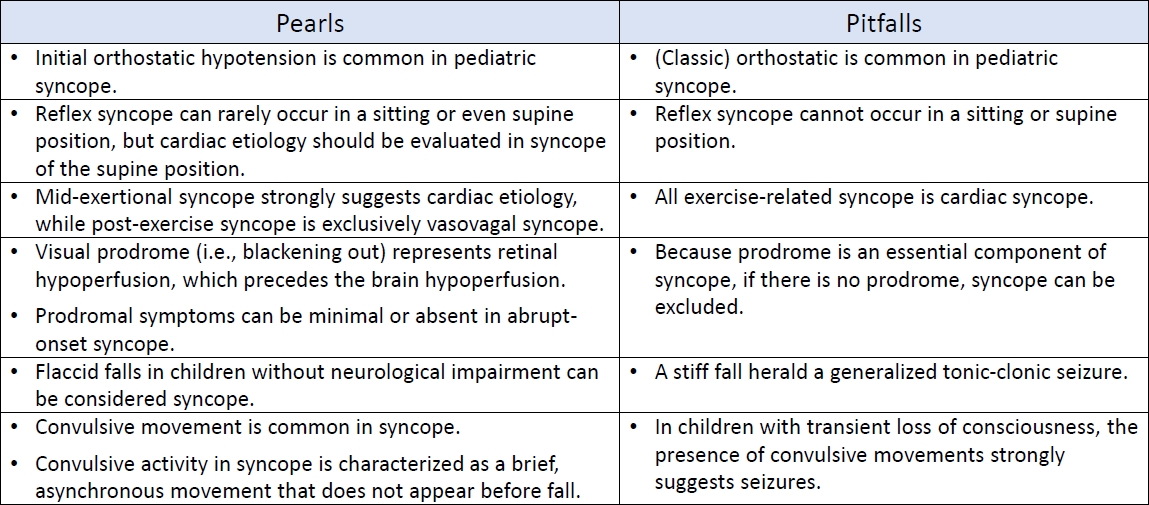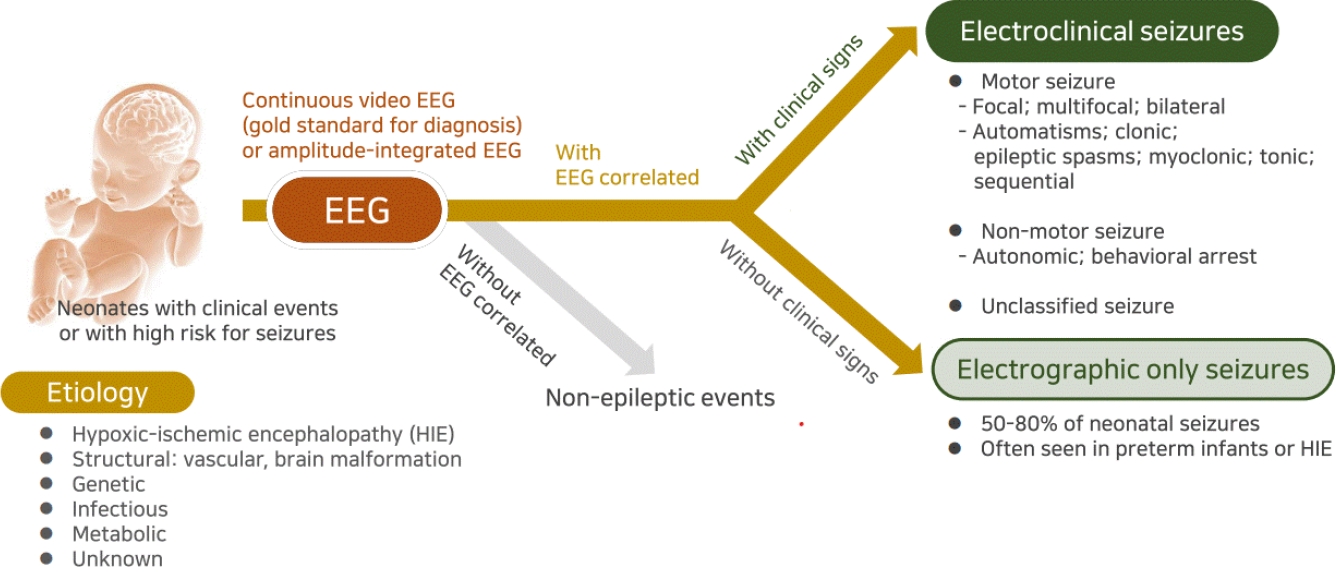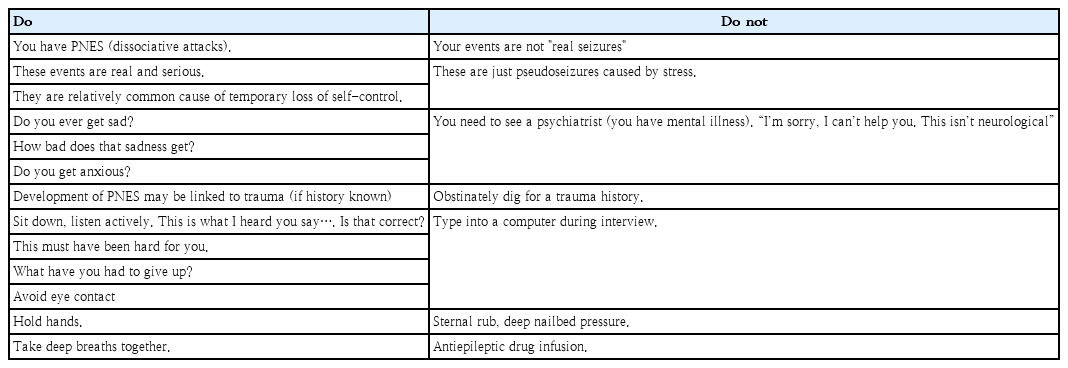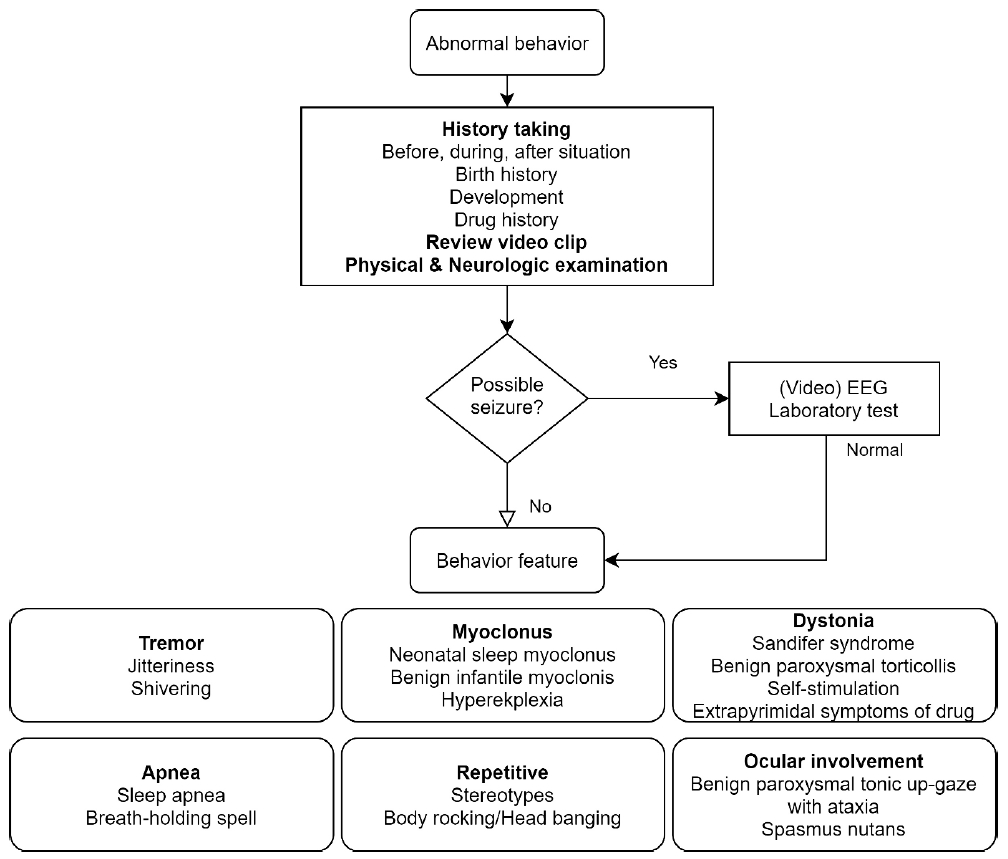Search
- Page Path
-
- HOME
- Search
- Original Article
- General Pediatrics
- The role of serum zinc and selenium levels in etiology of febrile seizures
- Yavuz Ataş, Hatice Gamze Poyrazoğlu
- Clin Exp Pediatr. 2025;68(5):388-394. Published online January 13, 2025
-

Zinc may play a key role in preventing febrile seizures by increasing the seizure threshold and reducing oxidative stress. Incorporating zinc supplements into treatment could help protect children from the adverse effects of febrile seizures and improve their overall outcomes.
- Neurology
- Changes in frequency of benign convulsions with mild gastroenteritis and their viral causes before and during the COVID-19 pandemic: a single-center study
- Hyejin Na, Sanghoon Lee, Seo Hee Kim, Young Ok Kim
- Clin Exp Pediatr. 2024;67(4):213-220. Published online March 19, 2024
-

Question: Did coronavirus disease 2019 (COVID-19) affect the frequency, seasonal variation, or virus type of benign convulsions with mild gastroenteritis (CwG)?
Findings: We compared 41 cases of CwG before and during the COVID-19 pandemic. After March 2020, frequency did not change significantly (18 patients vs. 23 patients), seasonal variation was lost, and number of cases of enteric adenovirus-associated CwG increased (1 cases vs. 7 cases).
Meaning: The COVID-19 pandemic affected CwG.
- Review Article
- Neurology
- Pediatric syncope: pearls and pitfalls in history taking
- Jung Sook Yeom, Hyang-Ok Woo
- Clin Exp Pediatr. 2023;66(3):88-97. Published online February 15, 2023
-

An accurate diagnosis depends on correct history taking and its interpretation. An in-depth understanding of the symptoms of syncope in connection with its pathophysiology can lead to avoiding critical pitfalls in the diagnostic process of history taking.
- Infection
- Pathogenetic and etiologic considerations of febrile seizures
- Ji Yoon Han, Seung Beom Han
- Clin Exp Pediatr. 2023;66(2):46-53. Published online January 13, 2023
-

· Inflammatory responses accompanying fever increase neuronal excitability in the central nervous system, which in turn provokes seizures.
· Fever in children with febrile seizures is usually caused by common respiratory viruses, the distributions of which match those of seasonal community-acquired respiratory tract infections.
· Several genetic variations in ion channels seem associated with neuronal hyperexcitability in children with febrile seizures.
- Neonatology (Perinatology)
- Neonatal seizures: stepping outside the comfort zone
- Menna Hashish, Mohamed Reda Bassiouny
- Clin Exp Pediatr. 2022;65(11):521-528. Published online April 4, 2022
-

· Use conventional and amplitude-integrated electroencephalography to confirm clinical seizures and screen high-risk newborns.
· Select an explicit clear elective event to be treated with less toxic and more effective antiepileptics.
- Neurology
- Neonatal seizures: diagnostic updates based on new definition and classification
- Eun-Hee Kim, Jeongmin Shin, Byoung Kook Lee
- Clin Exp Pediatr. 2022;65(8):387-397. Published online April 4, 2022
-

· Neonatal seizures are often electrographic-only seizures without clinical signs; therefore, the identification of electrical seizure activity on electroencephalography is the gold standard for diagnosis.
· Clinical signs of neonatal seizures are divided into motor or nonmotor seizures, and motor seizures are mostly focal or multifocal.
· Most neonatal seizures are caused by acute symptomatic etiologies, but in cases of intractable seizures, structural, genetic, or metabolic etiologies should be investigated.
- Update on benign convulsions with mild gastroenteritis
- Yeong Seok Lee, Ga Hee Lee, Young Se Kwon
- Clin Exp Pediatr. 2022;65(10):469-475. Published online December 27, 2021
-

∙ The main pathogen for benign convulsions with mild gastroenteritis (CwG) was previously rotavirus; however, cases associated with norovirus are increasing.
∙ CwG is characterized by clustered generalized seizures. Electroencephalography and magnetic resonance imaging show transiently abnormal findings in the acute phase that eventually normalize with progression. Its prognosis is good, and long-term treatment is unnecessary.
∙ There are many reports on the pathophysiological mechanism of CwG, which remains unclear.
- Myths and truths about pediatric psychogenic nonepileptic seizures
- Jung Sook Yeom, Heather Bernard, Sookyong Koh
- Clin Exp Pediatr. 2021;64(6):251-259. Published online October 17, 2020
-

• Psychogenic non-epileptic seizures (PNES) are events that look like epileptic seizures but are not caused by abnormal electrical discharges.
• PNES are a manifestation of psychological and emotional distress.
• Treatment for PNES does not begin with the psychological intervention but starts with the diagnosis and how the diagnosis is delivered.
• A multifactorial biopsychosocial process and a neurobiological review are both essential components when treating PNES
- Is it really a seizure? The challenge of paroxysmal nonepileptic events in young infants
- Seung Yeon Jung, Joon Won Kang
- Clin Exp Pediatr. 2021;64(8):384-392. Published online September 18, 2020
-

Paroxysmal nonepileptic events (PNE) comprise of a variety of nonepileptic behaviors and are divided into various types. A more accurate diagnosis is possible by examining the video clip provided by the caregiver. In infants, physiologic PNE accounts for the majority of the PNE. It is important to exclude epilepsy, for which blood tests, electroencephalography, and imaging tests can facilitate differential...
- Original Article
- Respiratory syncytial virus-associated seizures in Korean children, 2011–2016
- Teahyen Cha, Young Jin Choi, Jae-Won Oh, Chang-Ryul Kim, Dong Woo Park, In Joon Seol, Jin-Hwa Moon
- Clin Exp Pediatr. 2019;62(4):131-137. Published online October 23, 2018
-

Purpose: Respiratory syncytial virus (RSV) infection can cause various neurological complications. This study aimed to investigate the RSV-associated neurologic manifestations that present with seizures. Methods: We retrospectively reviewed the medical records of patients aged less than 15 years with laboratory-confirmed RSV infections and seizures between January 2011 and December 2016 in a regional hospital in South Korea. Results: During this period, 1,193...
- Neurology
- Effects of lamotrigine on attention-deficit hyperactivity disorder in pediatric epilepsy patients
- Seung-A Han, Eu Jeen Yang, Mi-Kyoung Song, Sun Jun Kim
- Clin Exp Pediatr. 2017;60(6):189-195. Published online June 22, 2017
-
Purpose The purpose of this study was to investigate the effects of lamotrigine for the treatment of attention-deficit hyperactivity disorder (ADHD) symptoms in children with epilepsy.
Methods Pediatric patients newly diagnosed with epilepsy (n=90 [61 boys and 29 girls]; mean age, 9.1±3.4 years) were enrolled. All patients were evaluated with the Korean ADHD rating scale (K-ARS)-IV before treatment with lamotrigine and after doses...
- Neonatology (Perinatology)
- Experience and pharmacokinetics of Levetiracetam in Korean neonates with neonatal seizures
- Jae Won Shin, Yun Seob Jung, Kyungsoo Park, Soon Min Lee, Ho Seon Eun, Min Soo Park, Kook In Park, Ran Namgung
- Clin Exp Pediatr. 2017;60(2):50-54. Published online February 27, 2017
-

Purpose The aims of this study were to evaluate the safety and pharmacokinetics of levetiracetam (LEV) in neonates with seizures and to establish a population pharmacokinetics (PPK) model by using the software NONMEM.
Methods A retrospective analysis of 18 neonatal patients with seizures, who were treated with LEV, including 151 serum samples, was performed. The mean loading dose was 20 mg/kg, followed by...
- Case Report
- Neurology
- Paroxysmal kinesigenic dyskinesia in a patient with a
PRRT2 mutation and centrotemporal spike discharges on electroencephalogram: case report of a 10-year-old girl - Sun Young Seo, Su Jeong You
- Clin Exp Pediatr. 2016;59(Suppl 1):S157-S160. Published online November 30, 2016
-
Coexistence of paroxysmal kinesigenic dyskinesia (PKD) with benign infantile convulsion (BIC) and centrotemporal spikes (CTS) is very rare. A 10-year-old girl presented with a 3-year history of frequent attacks of staggering while laughing and of suddenly collapsing while walking. Interictal electroencephalogram (EEG) revealed bilateral CTS, but no changes in EEG were observed during movement. The patient's medical history showed afebrile...
- 1p36 deletion syndrome confirmed by fluorescence
in situ hybridization and array-comparative genomic hybridization analysis - Dong Soo Kang, Eunsim Shin, Jeesuk Yu
- Clin Exp Pediatr. 2016;59(Suppl 1):S14-S18. Published online November 30, 2016
-
Pediatric epilepsy can be caused by various conditions, including specific syndromes. 1p36 deletion syndrome is reported in 1 in 5,000–10,000 newborns, and its characteristic clinical features include developmental delay, mental retardation, hypotonia, congenital heart defects, seizure, and facial dysmorphism. However, detection of the terminal deletion in chromosome 1p by conventional G-banded karyotyping is difficult. Here we present a case of...
- Review Article
- Neurology
- White matter injury following rotavirus infection in neonates: new aspects to a forgotten entity, 'fifth day fits'?
- Jung Sook Yeom, Chan-Hoo Park
- Clin Exp Pediatr. 2016;59(7):285-291. Published online July 31, 2016
-
That rotavirus infection can cause neurological symptoms in young children has been well established. However, it is surprising why rotavirus infection has been overlooked as a cause of neonatal seizures for many years, despite significant research interest in neonatal rotavirus infection. Neonates are the age group most vulnerable to seizures, which are typically attributed to a wide range of causes....
- Cognitive impairment in childhood onset epilepsy: up-to-date information about its causes
- Eun-Hee Kim, Tae-Sung Ko
- Clin Exp Pediatr. 2016;59(4):155-164. Published online April 30, 2016
-
Cognitive impairment associated with childhood-onset epilepsy is an important consequence in the developing brain owing to its negative effects on neurodevelopmental and social outcomes. While the cause of cognitive impairment in epilepsy appears to be multifactorial, epilepsy-related factors such as type of epilepsy and underlying etiology, age at onset, frequency of seizures, duration of epilepsy, and its treatment are considered...
- Original Article
- Neurology
- Epilepsy in children with a history of febrile seizures
- Sang Hyun Lee, Jung Hye Byeon, Gun Ha Kim, Baik-Lin Eun, So-Hee Eun
- Clin Exp Pediatr. 2016;59(2):74-79. Published online February 29, 2016
-
Purpose Febrile seizure, the most common type of pediatric convulsive disorder, is a benign seizure syndrome distinct from epilepsy. However, as epilepsy is also common during childhood, we aimed to identify the prognostic factors that can predict epilepsy in children with febrile seizures
Methods The study comprised 249 children at the Korea University Ansan Hospital who presented with febrile seizures. The relationship between...
- Intravenous levetiracetam versus phenobarbital in children with status epilepticus or acute repetitive seizures
- Yun-Jeong Lee, Mi-Sun Yum, Eun-Hee Kim, Tae-Sung Ko
- Clin Exp Pediatr. 2016;59(1):35-39. Published online January 22, 2016
-
Purpose This study compared the efficacy and tolerability of intravenous (i.v.) phenobarbital (PHB) and i.v. levetiracetam (LEV) in children with status epilepticus (SE) or acute repetitive seizure (ARS).
Methods The medical records of children (age range, 1 month to 15 years) treated with i.v. PHB or LEV for SE or ARS at our single tertiary center were retrospectively reviewed. Seizure termination was defined...
- Serum interleukin-1beta and tumor necrosis factor-alpha in febrile seizures: is there a link?
- Abolfazl Mahyar, Parviz Ayazi, Reza Orangpour, Mohammad Mahdi Daneshi-Kohan, Mohammad Reza Sarokhani, Amir Javadi, Morteza Habibi, Mousa Talebi-Bakhshayesh
- Clin Exp Pediatr. 2014;57(10):440-444. Published online October 31, 2014
-
Purpose Febrile seizures are induced by fever and are the most common type of seizures in children. Although numerous studies have been performed on febrile seizures, their pathophysiology remains unclear. Recent studies have shown that cytokines may play a role in the pathogenesis of febrile seizures. The present study was conducted to identify potential links between serum interleukin-1beta (IL-1β), tumor necrosis...
- Review Article
- Febrile seizures
- Sajun Chung
- Clin Exp Pediatr. 2014;57(9):384-395. Published online September 30, 2014
-
Febrile seizure (FS) is the most common seizure disorder of childhood, and occurs in an age-related manner. FS are classified into simple and complex. FS has a multifactorial inheritance, suggesting that both genetic and environmental factors are causative. Various animal models have elucidated the pathophysiological mechanisms of FS. Risk factors for a first FS are a family history of the...
- Benign convulsion with mild gastroenteritis
- Ben Kang, Young Se Kwon
- Clin Exp Pediatr. 2014;57(7):304-309. Published online July 23, 2014
-
Benign convulsion with mild gastroenteritis (CwG) is a type of afebrile seizure that occurs in children. CwG is defined as a convulsion in a previously healthy child with no known central nervous system infection or encephalopathy, accompanying mild diarrhea without fever, electrolyte imbalance, or moderate to severe dehydration. Convulsions in CwG are characterized by multiple brief episodes of generalized or...
- Original Article
- Early postictal electroencephalography and correlation with clinical findings in children with febrile seizures
- Kyung A Jeong, Myung Hee Han, Eun Hye Lee, Sajun Chung
- Clin Exp Pediatr. 2013;56(12):534-539. Published online December 20, 2013
-
Purpose Electroencephalography (EEG) is frequently ordered for patients with febrile seizures despite its unclear diagnostic value. We evaluated the prevalence of abnormal EEGs, the association between clinical findings and abnormal EEGs, and the predictive value of EEG for the recurrence of febrile seizures.
Methods Data were collected on 230 children who were treated for febrile seizures at Kyung Hee University Medical Center from...
- Review Article
- The role of cytokines in seizures: interleukin (IL)-1β, IL-1Ra, IL-8, and IL-10
- Youngah Youn, In Kyung Sung, In Goo Lee
- Clin Exp Pediatr. 2013;56(7):271-274. Published online July 19, 2013
-
Brain insults, including neurotrauma, infection, and perinatal injuries such as hypoxic ischemic encephalopathy, generate inflammation in the brain. These inflammatory cascades induce a wide spectrum of cytokines, which can cause neuron degeneration, have neurotoxic effects on brain tissue, and lead to the development of seizures, even if they are subclinical and occur at birth. Cytokines are secreted by the glial...
- Original Article
- Selenium and leptin levels in febrile seizure: a case-control study in children
- Abolfazl Khoshdel, Neda Parvin, Maedeh Abbasi
- Clin Exp Pediatr. 2013;56(2):80-85. Published online February 25, 2013
-
Purpose Febrile seizures (FS) are seizures that occur between the age of 6 and 60 months, but its pathophysiology still is not fully understood. There is limited information about the correlation between levels of selenium and leptin with FS. This study aimed to determine the relationship between serum levels of selenium and leptin in children with FS.
Methods This case-control study was conducted...
- Review Article
- Cognitive function of idiopathic childhood epilepsy
- Su Jeong You
- Clin Exp Pediatr. 2012;55(5):159-163. Published online May 21, 2012
-
Most children with epilepsy are of normal intelligence. However, a significant subset will have temporary or permanent cognitive impairment. Factors that affect cognitive function are myriad and include the underlying neuropathology of the epilepsy, seizures, epileptiform discharges, psychosocial problems, age at seizure onset, duration of epilepsy, and side effects associated with antiepileptic drugs. This review article discusses cognitive function in...
- Case Report
- A case of Hashimoto's encephalopathy presenting with seizures and psychosis
- Min-Joo Lee, Hae-Sang Lee, Jin-Soon Hwang, Da-Eun Jung
- Clin Exp Pediatr. 2012;55(3):111-113. Published online March 16, 2012
-
Hashimoto's encephalopathy (HE) is a rare, poorly understood, autoimmune disease characterized by symptoms of acute or subacute encephalopathy associated with increased anti-thyroid antibody levels. Here, we report a case of a 14-year-old girl with HE and briefly review the literature. The patient presented with acute mental changes and seizures, but no evidence of infectious encephalitis. In the acute stage, the...
- Transient splenial lesion of the corpus callosum in a case of benign convulsion associated with rotaviral gastroenteritis
- Yoon Young Jang, Kye Hyang Lee
- Clin Exp Pediatr. 2010;53(9):859-862. Published online September 13, 2010
-
Transient magnetic resonance (MR) signal changes in the splenium of the corpus callosum (SCC) arise from many different conditions, including encephalopathy or encephalitis caused by infection, seizures, metabolic derangements, and asphyxia. Few case reports exist on reversible SCC lesions associated with rotavirus infection. A benign convulsion with mild gastroenteritis (CwG) is frequently associated with rotaviral infections. This entity is characterized...
- Review Article
- Diagnosis of neonatal seizures
- Hee Jung Chung, Yun Jung Hur
- Clin Exp Pediatr. 2009;52(9):964-970. Published online September 15, 2009
-
Neonatal seizures are generally not only brief and subtle but also not easily recognized and are usually untreated. In sick neonates, seizures are frequently not manifested clinically but are detected only by electroencephalography (subclinical EEG seizures). This phenomenon of electroclinical dissociation is fairly common in neonates. On the other hand, neonates frequently show clinical behaviors such as stiffening, apnea, or... -
- Neonatal seizures in Korea, 1983-2009
- Eun Sook Suh
- Clin Exp Pediatr. 2009;52(9):957-963. Published online September 15, 2009
-
Neonatal seizures are the most common and distinctive clinical sign of prenatal and/or neonatal brain disorders. Newborn infants with seizures are at risk of mortality and survivors at risk for neurologic impairment, developmental delay, and subsequent epilepsy. Fifteen reports on neonatal seizures in Korea from 1983 to 2009 were analyzed. A total of 731 neonatal seizure cases were reported. Day... -
- Original Article
- Inherited metabolic diseases in the urine organic acid analysis of complex febrile seizure patients
- Hee Jeong Cheong, Hye Rim Kim, Seong Soo Lee, Eun Joo Bae, Won Il Park, Hong Jin Lee, Hui Chul Choi
- Clin Exp Pediatr. 2009;52(2):199-204. Published online February 15, 2009
-
Purpose : Seizure associated with fever may indicate the presence of underlying inherited metabolic diseases. The present study was performed to investigate the presence of underlying metabolic diseases in patients with complex febrile seizures, using analyses of urine organic acids. Method : We retrospectively analyzed and compared the results of urine organic acid analysis with routine laboratory findings in 278... -
-

-
-
6.02024CiteScore98th percentilePowered by
-
Impact Factor3.6
-
- TOPICS
- ARTICLE CATEGORY
- Editorial Office
-
Korean Pediatric Society
#1606 Seocho World Officetel, 19 Seoun-ro, Seocho-ku, Seoul 06732, Korea
Tel: +82-2-3473-7306 Fax: +82-2-3473-7307 E-mail: office@e-cep.org
Clinical and Experimental Pediatrics is an open access journal. All articles are distributed under the terms of the Creative Commons Attribution NonCommercial License (http://creativecommons.org/licenses/by-nc/4.0/)
Copyright © 2025 by Korean Pediatric Society.











